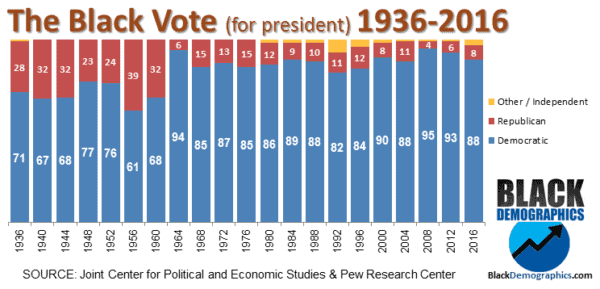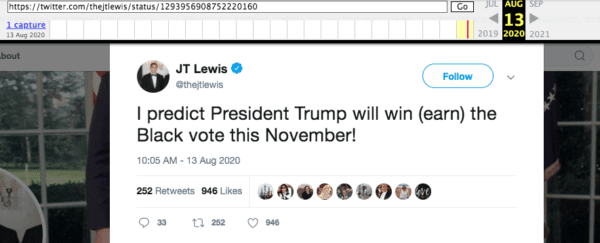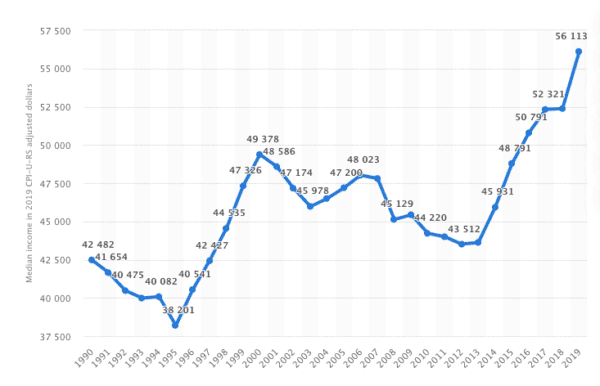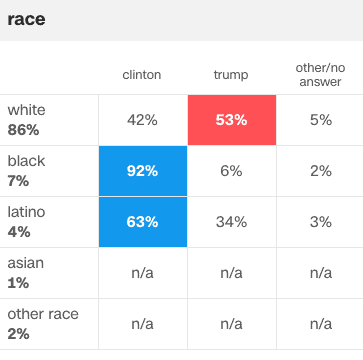The GOP is Still the White Party, and American Politics are as Racial as Ever
Chris Roberts, American Renaissance, November 6, 2020
According to exit polls, which are subject to revision, Donald Trump’s share of the non-white vote was higher in 2020 than 2016, but the increase was very small.
| Group | Donald Trump’s Share in 2016 | Donald Trump’s Share in 2020 |
| Hispanic |
28 percent |
32 percent |
| Asian |
27 percent |
31 percent |
|
Black |
8 percent |
12 percent |
| Other |
36 percent |
40 percent |
Some may be tempted to write about these numbers deceptively: “In 2020, Donald Trump won 150 percent of his 2016 share of the black vote.” That’s true — 12 percent is 150 percent of 8 percent, but it’s still a small number, and it lacks context. Since 1964, Republican presidential candidates have won between 4 and 15 percent of the black vote. In 2016, Mr. Trump was on the low end of that range; in 2020, he reached its high end. However, it is not exceptionally high, and out of 12 other Republican candidacies since 1964, five did as well as Mr. Trump or better.

Almost every election, conservative Pollyannas claim this will be the year the GOP wins one third of the black vote. This year, like every other, proved them wrong.
Trump is going to win more of the black vote than any Republican in history.
— thebradfordfile™ (@thebradfordfile) August 12, 2020
It’s pretty clear they’re freaking out about losing the black vote. Which they do deserve to lose.
Prediction: Trump gets 30% of the black vote.
— Dave Rubin (@RubinReport) February 8, 2020

The President did better with Asians this time, but again, look at past elections:
| Year | GOP Share of the Asian Vote |
| 1992 |
55 percent |
| 1996 |
48 percent |
|
41 percent |
|
| 2004 |
43 percent |
| 2008 |
35 percent |
| 2012 |
26 percent |
| 2016 |
27 percent |
| 2020 | 31 percent |
Mr. Trump increased his Asian vote by 4 percent, but that put him ahead of just one other Republican candidate: Mitt Romney.
Mr. Trump also improved his score with Hispanics, but still won only a typical Republican share:
| Year | GOP Share of Hispanic Vote |
| 1980 | 35 percent |
| 1984 | 37 percent |
| 1988 | 30 percent |
| 1992 | 25 percent |
| 1996 | 21 percent |
| 2000 | 35 percent |
| 2004 | 40 percent |
| 2008 | 31 percent |
| 2012 | 27 percent |
| 2016 | 28 percent |
| 2020 | 32 percent |
As with Georgie W. Bush in 2000 and 2004, two states gave him a big push with Hispanics: Texas and Florida, where a large share of Hispanics live, and where they are most conservative and most likely to consider themselves white. In 2016, candidate Trump won 34 percent of Texas Hispanics; in 2020 he won 40 percent. In 2016, Trump won 35 percent of Florida Hispanics; in 2020 he won 47 percent.
As more data are collected and analyzed, these numbers may change, but they’re not likely to be way off. The Trump campaign, conservative Super PACs, and the GOP spent hundreds of millions of dollars appealing to non-whites — they even bought Spanish-language ads. Some middle-class non-whites — Asians and Hispanics in particular — may have voted Republican because they are afraid that a President Biden would impose COVID shutdowns, making it harder for them to make a living; others may have voted for President Trump because they associate last summer’s riots with the Left and want law and order. Hispanics also tend to vote for Republicans in higher numbers when they are doing better economically (regardless of how the economy as a whole is doing), and more of them are entering the middle-class than ever before. Here are median household incomes for Hispanics:

Source: Statista
Whatever caused it, Donald Trump’s increase in non-white support was not worth his loss in white support.
Not only are whites still the majority of voters, non-whites are largely concentrated in states where slight increases in their support makes no difference. This is especially true of Asians, the only non-white group to have voted majority-Republican in the last 30 years (1992). They are just 3 percent of the electorate, and most of them live in four states in which Democrat-supermajorities usually control all levels of government: Hawaii, California, Oregon, and Washington. Of the four, only Hawaii has enough Asians to flip the state Republican.
Most blacks live either in big cities or in the South. In places such as Louisiana and Mississippi, the two states with the highest black population, politics are racial: Blacks vote Democrat and whites vote Republican. Since there are more whites, those states are red. Increasing the Republican share of the black vote by 3 or 4 or even 20 percent would make no difference.
In the Midwest, where many white supermajority states have black cities, a slight increase in white support outside the cities is much more important for Republicans. Consider Wisconsin:


In 2020, Donald Trump gained one percentage point with blacks and one with Hispanics, while losing one with whites. This year, Joe Biden got four percent more of the white vote than Hillary Clinton did in 2016 (minor-party candidates took many white votes). In 2016, Mr. Trump won. In 2020, it’s still not clear. The white vote matters most.
Across the Midwest, Mr. Trump lost white support and gained non-whites, but in every case, lost overall. In 2016, Minnesota almost went red, with 50 percent of whites voting for Donald Trump and 43 percent for Hillary Clinton. In 2020, Mr. Trump lost the state by over seven points, with 51 percent of whites voting for Joe Biden, and only 48 percent voting for the President. Whatever gains he made with non-whites in Minneapolis and St. Paul didn’t matter. A slight increase in his 2016 white share would have won him the state.
Even in regions less white than the Midwest, the GOP’s new non-white support didn’t help. In 2016, in Arizona, the white vote was 54 percent Republican and 40 percent Democrat; Mr. Trump won the state 48.08 percent to 44.58 percent. In 2020, Democrats won 8 percent more of the white vote and Republicans lost 6 percent; Mr. Biden is winning Arizona. In Georgia, Donald Trump lost 5 percent of the white vote and the Democrats gained 8 percent. Mr. Trump was up 2 percent of the black vote and a substantial 14 percent of the Hispanic vote. In 2016, Mr. Trump won the state by over five points. In 2020, the state is still undecided.
For the last four years, the President appealed to non-whites but did very little for whites. He succeeded in attracting a few more non-whites, but not nearly enough to make up for the whites he lost. If he loses this election, it’s because he didn’t keep the voters he needed most: white people.















